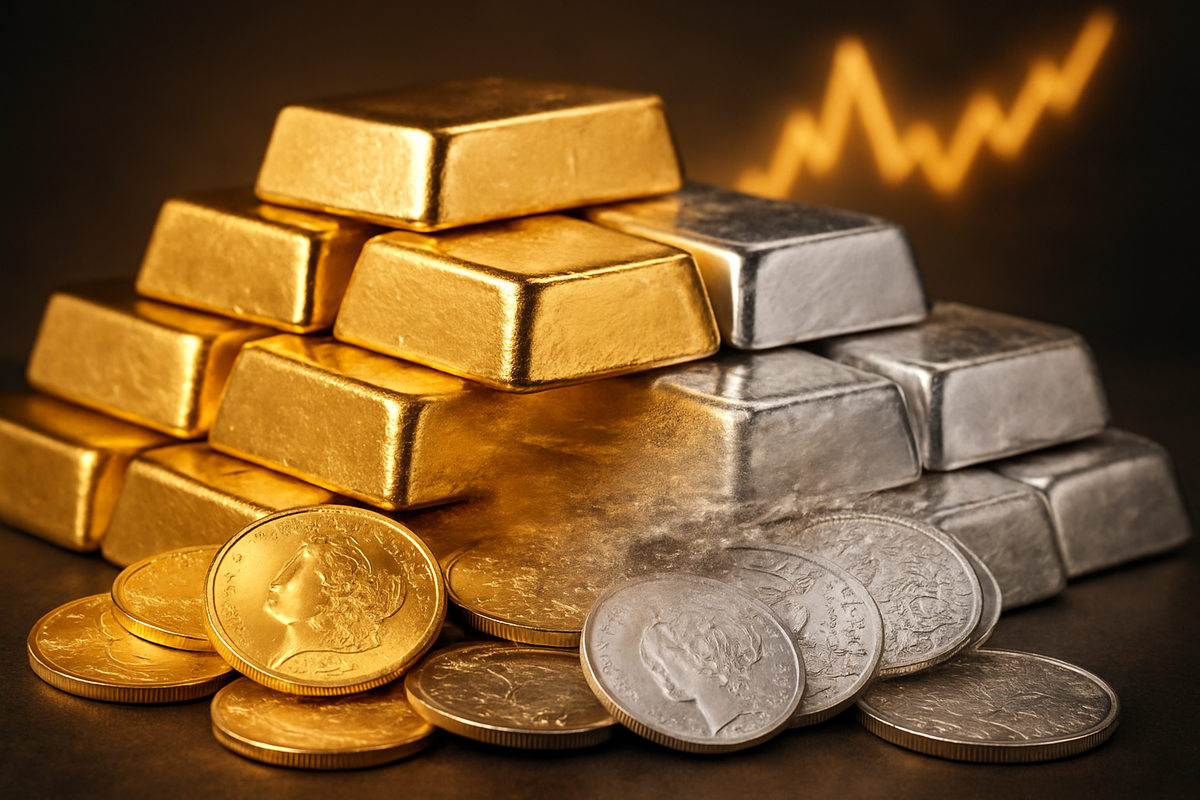
The numismatic market, a niche realm where history and artistry often command value far exceeding intrinsic metal content, is currently grappling with unprecedented challenges. As highlighted in Greysheet's Editor's Letter for November 2025, a sustained surge in precious metals prices has fundamentally reshaped the landscape, effectively eliminating traditional numismatic premiums and precipitating severe cash flow crises for smaller operators. This dramatic shift means that many coins, once valued for their rarity or historical significance, are now trading precariously close to, or even below, their melt value, transforming collector's items into mere bullion.
This market upheaval carries immediate and profound implications. For the backbone of the industry – the independent, often family-run coin shops – the cost of maintaining inventory has skyrocketed, while profit margins have evaporated. The delicate balance between acquiring unique pieces and ensuring business liquidity has been shattered, forcing many to re-evaluate their operations in an environment where capital is king and traditional numismatic value is increasingly overshadowed by the volatile price of gold and silver.
Unprecedented Price Surge Erodes Numismatic Value
The current crisis for numismatic premiums is a direct consequence of a sustained and dramatic rally in precious metals. Gold prices, in particular, have been on an unprecedented ascent throughout 2024 and 2025, breaching the $2,900 per ounce mark in February 2025, peaking at $3,500 in April, and even briefly surpassing $4,300 per ounce in early October 2025 before a slight moderation. Silver has mirrored this surge, breaking $30.00 per ounce in March 2024 and reaching a high of $54.46 on October 17, 2025, now trading around $51.02 per ounce as of November 14, 2025. This robust performance, driven by geopolitical uncertainties, inflation concerns, central bank demand, and industrial applications for silver, has fundamentally altered the value proposition of many coins.
For the numismatic market, this means that the intrinsic metal content of a coin now often overshadows its collector premium. Common-date U.S. gold coins, such as $5, $10, and $20 denominations, have seen their premiums over melt value "all but disappear." Even modern bullion-related issues, like high-grade Silver Eagle Dollars, are at risk of being valued primarily as bulk metal. This erosion of premiums directly translates into razor-thin, or even negative, profit margins for dealers, making it challenging to cover operational costs. In some instances, dealers are quoting prices below melt value for various U.S. and worldwide gold and silver coins, with larger discounts for silver due to a reported acute shortage in the London market for physical delivery.
This environment presents significant operational hurdles for smaller numismatic operators. The sheer capital required to acquire inventory has surged dramatically; a dealer needing to stock ten Double Eagles, for example, now faces an approximately $40,000 outlay. This increased cost ties up crucial capital, hindering less-capitalized businesses from maintaining diverse stock or making new purchases. Compounding this, high prices can deter collectors, leading to slower inventory turnover and further locking up capital. Moreover, the costs associated with third-party grading for generic gold coins, once easily recouped through premiums, are now difficult to recover, adding another layer of financial strain. The record-high silver prices have also led to widespread liquidation, creating bottlenecks at refiners, some of whom prioritize .999 fine silver, making it harder for dealers to convert lower-purity items like 90% silver coins into cash.
Shifting Fortunes: Who Benefits and Who Bears the Brunt
The current market dynamics are creating a distinct divide between potential winners and losers within the broader precious metals and numismatic ecosystem. On one side, larger bullion dealers and precious metal refiners are generally finding themselves in a more advantageous position. Companies like APMEX (private), while not publicly traded, represent the type of large-scale bullion operation that can leverage economies of scale to manage high-volume transactions driven by elevated metal prices. Similarly, major precious metal mining companies such as Newmont Corporation (NYSE: NEM) or Barrick Gold Corporation (NYSE: GOLD) benefit directly from the sustained high prices of their primary products, seeing increased revenues and potentially higher profit margins from their mining operations. Refiners, especially those equipped to handle large quantities of .999 fine silver and gold, are also experiencing increased business due to the widespread liquidation of precious metal items.
Conversely, the brunt of the impact is being borne by smaller, independent numismatic operators. These businesses, often characterized by limited capital and a reliance on the nuanced valuation of collector premiums, are struggling immensely. The dramatic increase in the cost of inventory means that a significant portion of their available capital is tied up in fewer items, severely limiting their ability to diversify stock or respond to market opportunities. With premiums largely eliminated, their traditional profit margins have vanished, making it difficult to cover overheads like rent, salaries, and insurance. Many small coin shops, unable to compete on sheer volume or absorb the higher capital requirements, face increased business risk and potential closure.
Collectors of common-date gold and silver coins are also experiencing a shift. While the intrinsic value of their holdings has increased, the numismatic appeal and potential for premium-driven resale have diminished. This could lead to a two-tiered market where ultra-rare, high-grade coins continue to command strong premiums, while more common issues are increasingly traded as commodities, blurring the lines between collecting and pure investment in bullion. The increased capital required for even common items might price out many casual collectors, potentially leading to a contraction in certain segments of the numismatic hobby.
Broader Implications and Historical Echoes
The current scenario in the numismatic market is not an isolated event but rather a pronounced manifestation of broader industry trends and economic forces. The most significant trend is the accelerating shift towards a more bullion-centric valuation for a wide array of precious metal coins. This blurs the traditional lines between numismatics and commodity trading, pushing many items that once commanded collector premiums into a realm where their value is almost entirely dictated by the fluctuating spot price of gold and silver. This market contraction for certain segments, particularly common-date issues, means a shrinking pool of traditional numismatic buyers, as many are priced out or see little incentive to pay above melt value.
The ripple effects extend beyond the immediate dealers and collectors. Auction houses, which thrive on the unique appeal and rarity of numismatic items, may find fewer common-date gold and silver pieces commanding significant bids, potentially shifting their focus further towards truly rare and high-grade specimens. Grading services, such as Professional Coin Grading Service (PCGS) and Numismatic Guaranty Company (NGC), might see a reduction in submissions for generic material, as the cost of grading becomes harder to justify without a corresponding numismatic premium. Suppliers to the coin industry, from display case manufacturers to numismatic literature publishers, could also face reduced demand if smaller dealers struggle or exit the market.
Historically, the numismatic market has faced similar pressures during periods of extreme precious metal volatility. The most notable precedent occurred during the late 1970s and early 1980s, when gold soared to over $800 per ounce and silver briefly touched $50 per ounce, partly fueled by the Hunt brothers' attempt to corner the silver market. During this era, common-date U.S. gold coins also saw their premiums vanish, and "junk silver" bags sometimes traded at a discount due to an oversupply from widespread liquidation. More recently, the 2008 financial crisis and the COVID-19 pandemic also saw gold and silver surge, leading to similar compressions of premiums for less rare items. These historical parallels underscore the cyclical nature of this challenge, highlighting that while the current prices are unprecedented, the market's reaction, particularly the erosion of premiums, is a well-established phenomenon. This current surge, however, is notable for its prolonged nature and the sheer magnitude of the price increases, making the impact particularly acute for smaller, less capitalized operators.
Navigating the Future: Strategic Pivots and Emerging Opportunities
Looking ahead, the numismatic market is poised for a period of significant adaptation, particularly for its smaller operators. In the short term, the pressure from elevated metal prices and the absence of premiums are expected to persist, necessitating immediate strategic pivots. Businesses that can quickly adjust their inventory away from common-date, bullion-heavy items and towards true numismatic rarities and high-grade specimens will be better positioned to weather the storm. The focus will increasingly be on coins whose value is intrinsically tied to their rarity, historical significance, and condition, rather than their melt value.
In the long term, successful small numismatic businesses will likely embrace diversification and a stronger online presence. Expanding into specialized services like collection appraisals, personalized sourcing, and educational content can create new revenue streams and build deeper customer loyalty. There's also a growing opportunity in exploring new coin categories, such as world coins, ancient coins, or specific thematic collections, which may offer more stable premiums and attract a broader, often younger and tech-savvy, collector base. The market will also demand enhanced security protocols from dealers, given the unfortunate rise in numismatic-related crimes linked to high metal values.
Despite the challenges, opportunities are emerging. The continued growth in demand for ultra-rare and high-grade coins, driven by both traditional collectors and new investors seeking tangible assets, presents a lucrative niche. Limited edition and commemorative coins from mints can become "instant modern rarities," attracting strong collector interest. Furthermore, the numismatic market's role as a hedge against inflation and economic uncertainty continues to appeal to a segment of investors, encouraging the creation of "blended" portfolios that strategically combine bullion and numismatic items. Businesses that effectively educate their customers about the long-term investment potential and intrinsic value of genuinely rare pieces will be better equipped to thrive in this evolving landscape.
A Resilient Market Adapting to New Realities
The current environment, marked by historically elevated precious metal prices, represents a critical juncture for the numismatic business. The core takeaway is the profound impact on traditional numismatic premiums, which have largely evaporated for common-date gold and silver coins. This shift has created significant cash flow issues for smaller, less capitalized operators, who now face drastically increased inventory costs and severely compressed profit margins. While large bullion dealers and precious metal miners may benefit from the increased trading volume and value of raw materials, the backbone of the numismatic hobby—the independent coin shop—is undergoing an existential challenge.
Moving forward, the market is poised for continued adaptation. The distinction between bullion and numismatic items will become sharper, with true rarities maintaining their value and common items increasingly trading near their melt value. This necessitates a strategic pivot for dealers towards high-grade, historically significant, and genuinely rare coins, along with a diversification of services and an enhanced digital presence. The resilience of the numismatic market has been tested before by similar, albeit less intense, periods of high metal prices, suggesting that while the landscape will change, the core appeal of collecting and investing in tangible assets will endure.
Investors and collectors alike should closely monitor the trajectory of precious metal prices, as any significant correction could reintroduce premiums and alleviate some of the current pressures. However, even with a correction, the lessons learned from this period—the importance of capital management, strategic inventory, and focusing on intrinsic numismatic value—will likely shape the industry for years to come. The market will continue to value rarity and condition above all else for numismatic pieces, while the role of precious metal coins as a tangible asset and inflation hedge will remain prominent. The coming months will reveal which operators successfully navigate this challenging period by embracing innovation and focusing on the enduring allure of numismatic treasures.
This content is intended for informational purposes only and is not financial advice


















